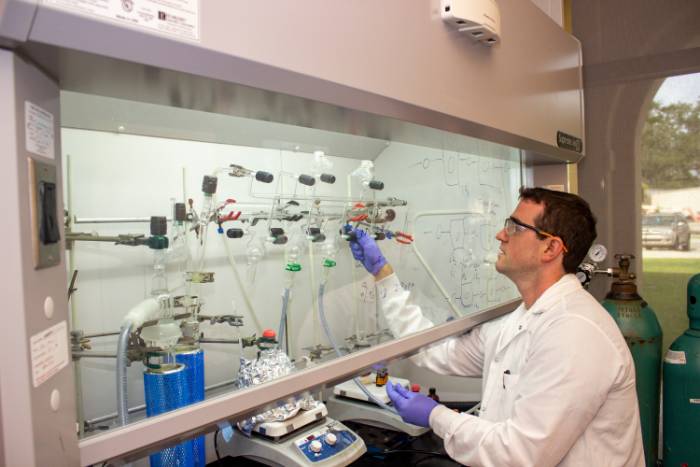Breaking the Bond: LSU ChE Professor Creates Reactor-Separator to Upgrade Methane

A century ago, natural gas was not the hot commodity it is today. A byproduct of oil production, or fracking, natural gas is now abundant and low-cost, resulting in its high demand for energy production.
The gas not only powers homes and cars, but the hydrocarbons that make up the gas, such as methane, can be converted and used for creating other products like fuel and plastic. The trick is separating, or breaking, the bond between carbon and hydrogen to make methane consumable. For the past year, LSU Chemical Engineering Assistant Professor Chris Arges has undertaken that very task.
“The emergence of low-cost natural gas has motivated many scientists and engineers to devise new processes to convert natural gas into high-value chemicals, rather than just burning it to power homes and vehicles, its lowest value,” Arges said. “The reason we’re working on this is so we come up with a new way to convert natural gas, which is mainly composed of methane, into other products such as liquid fuels like gas or jet fuel, or more importantly, other chemicals that can be used to make plastics and other consumable products that are found everywhere. It’s a very difficult proposition. The C-H bond in methane is hard to break.”
Currently, plants and companies upgrade methane through a process called steam reforming, followed by the Fischer-Tropsch process, which is energy-intensive and cost-prohibitive.
“There are only six gas-to-liquid (GTL) plants worldwide, none of which are in the U.S. because it doesn’t financially make sense,” Arges said. “Part of the reason why is you need a lot of energy to run that process. If you come up with a smaller, more modular technology that’s more effective, it’s very transformative. You can develop these plants in more diverse geographical locations, besides the fact that it would also cost less to make jet fuel, gas, and the building blocks for plastics and a variety of other chemicals.”
Thanks to a $50,000 LSU LIFT2 grant, Arges and his team have been developing a reactor-separator that can upgrade methane into higher-order carbons which can be used to make consumable products while simultaneously producing hydrogen.
“John Flake [LSU Cain Department of Chemical Engineering chair] encouraged me to look at methane upgrading as a research topic from an electrochemistry perspective,” Arges said. “Almost no one has been looking at this route. By employing an electrochemical reactor, which is what we’re doing versus high-temperature reactors, you really have two driving forces at your disposal—heat and electrode potential. When you combine those two, you can be a lot more effective.
“We have shown in three-cell electrode setups that the electrochemical process works to convert methane to ethylene, but it isn’t conducive for a production scale. The LSU LIFT2 grant allows us to redesign the electrochemical reactor using all solid-state materials with gas feeds. This design is modular and scalable. A surprising by-product of the reactor is also hydrogen, and the reactor separates the hydrogen from the upgraded methane products—an example of process intensification.”
The reactor, which Arges normally uses to run fuel cell experiments, has been outfitted to convert methane into ethane, ethylene, and other large alkane/alkene molecules. To get the process to work, the reactor must be dry and operate above 100°C.
“If you run these fuel cells north of 100°C, the conventional fuel cell membranes used to help carry out the reactions cannot be used,” Arges said. “We had to develop a new class of proton-conducting membranes that conduct above 100°C and under dry conditions while also being resilient to the harsh reactor conditions.”
Though Arges has expertise in polymer membranes for electrochemical systems and has applied his membranes to water desalination, fuel cells, and flow batteries, this is the first time he has tailored this class of membranes to conduct under dry conditions and at temperatures greater than 100°C.
The new set of membranes invented by Arges’ team also has utility for other technologies being researched at LSU.
“We’re working with other people, like Manas Gartia [LSU Mechanical Engineering assistant professor], who works on supercapacitor devices,” Arges said. “The membranes will help the supercapacitors, which are fast charging-discharging batteries, to run more effectively. Our membranes’ solid-state, flexible design will help realize smaller and flexible portable electronic devices.”
From a commercial standpoint, Arges and his team are working to improve the proof of concept. He currently has a provisional patent on the project, with plans to establish a final patent in Spring 2019. In the meantime, he and his team are focused on showing how well the reactor-separator performs.
“We know that it works in the three-electrode cell setup,” he said. “Our design is modular technology that’s scalable. That’s what I think our customers, or people who understand what we’re doing, would appreciate. If you can reduce the energy amount by half to convert methane, or even ethane, to useful products, which we think we’ll be able to do, that translates into $50 billion saved in operating costs per year globally.”
As for a completion date on the project, Arges does not want to set anything in stone.
“There’s a tall order here,” he said. “Many smart people have been trying to find ways to upgrade methane for a long time. Even if everything does not pan out, we think the reactor design and the new materials being developed will be useful for other things. That’s the one thing I’ve learned in my short career. Maybe you won’t reach your final goal, but you’ll probably make some other discoveries along the way that will be useful.”
Like us on Facebook (@lsuengineering) or follow us on Twitter and Instagram (@lsuengineering).
###
Contact: Libby Haydel
Communications Specialist
225-578-4840